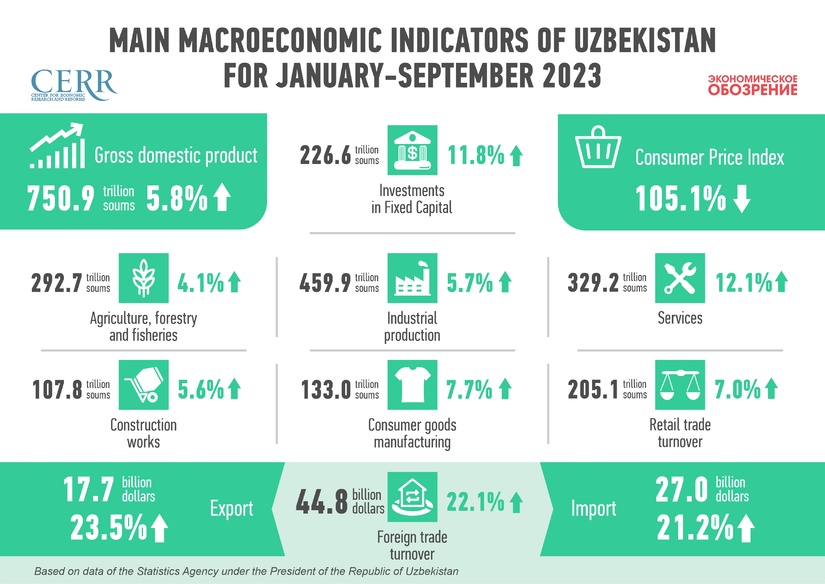According to the Statistics Agency, Uzbekistan's gross domestic product (GDP) grew by 5.8%, which is slightly less than the growth rate for the same period of the previous year (6.2%).
Despite the persistence of geopolitical instability affecting the global economy, in general, a favorable economic environment was developing in the main trading partner countries. In Kazakhstan, GDP grew by 4.7% in 9 months, in Kyrgyzstan by 4.2%. According to the estimates of the Ministry of Economic Development of the Russian Federation, Russia's GDP in January-August increased by 2.5% compared to the same period of the previous year.
Inflation in Uzbekistan is slowing down. In January-September, prices increased by 5.1%, which is lower than in the same periods in the previous 5 years. Food inflation for the period under review slowed down to 5.6% (for 9 months of 2022 – 10%). Prices for non-food products increased by 4.8% (7.9% for the same period in 2022), services by 4.7% (4.8%).
The growth of investments in fixed assets increased significantly from 3.3% in 9 months of 2022 to 11.8% in the same period of 2023. Double–digit growth dynamics is observed for non-centralized investments - an increase of 13.6% in January-September of this year. In particular, high growth rates are noted for attracting foreign direct investment and loans – 16.3% (at the same time, the volume of foreign direct investment increased by 47%), due to loans from commercial banks – 27%. Investments at the expense of the population also increased by 10.6%.
Centralized investments increased by 1.3% due to a 23.5% increase in government-guaranteed loans this year.
The share of non–centralized investments continues to increase – 86.9% (in January–September 2022 - 85.5%).
During the period under review, all sectors of the economy showed an increase in production.
Agriculture is growing at a faster pace – 4.1% for 9 months of this year, against a 3.6% growth in January-September 2022. Crop production, livestock and forestry accelerated, while fisheries production slowed slightly – 10.9% (in January-September 2022 – 18.1%).
The industry grew by 5.7% in 9 months of 2023, which is higher than in January-September 2022 - 5.3%. The main driver is the manufacturing industry, which showed an increase of 6.4% (5.4% in 9 months of 2022), and the production of the water supply, waste collection and disposal sector also increased. The extractive sector, although there is an increase of 0.4%, but it is lower than last year (1.1%). In the electricity, gas supply and air conditioning sector, the growth rate slowed from 14.7% in January-September 2022 to 8.9% in 9 months of this year.
It is also necessary to note the slowdown in the growth of consumer goods production from 27% in 9 months of 2022 to 7.7% for the same period in 2023.
There is a slight slowdown in the dynamics in the construction sector this year. So, if for 9 months of 2022 the growth was 6.6%, then in January-September 2023 it slowed down to 5.6%.
During the period under review, the volume of market services provided increased by 12.1% (in January-September 2022 – 15.4%). Growth is observed in all sectors. In particular, information and communication services showed the highest growth rates – 24.8%, education – 23.5%, financial services – 18.2%, accommodation and catering services – 10.9%, real estate transactions – 10.2%. The volume of transport services increased by 7.3%. The growth rates of cargo turnover and passenger turnover have slowed down.
The volume of retail turnover increased by 7%, but this is lower than in the same period last year – 10.8%.
The volume of foreign trade in January-September 2023 increased by 22.1% to $44.8 billion. Despite the significant growth, this is less than in the same period last year – 29.4%. Export increased by 23.5% to $17.7 billion, import by 21% to $27 billion.
The export growth is due to an increase in the supply of gold abroad by almost 90%, as well as machinery and transport equipment by 44%, services by 21%, finished products by 20%, food products by 19%.
At the same time, Uzbekistan has increased imports of machinery and transport equipment by 45%, fuel products by 45%, finished products by 14%, chemical products by 14%.
***
In general, following the results of 9 months, the economy of Uzbekistan continued a positive growth trend within the planned development vector. The growth of investment activity contributes to overcoming internal and external challenges, in addition, the trend towards a decrease in inflation continues, which also leads to stabilization of the economic environment. At the same time, additional risks are created by increased volatility of the national currency and an increase in the budget deficit.
At the end of the year, the dynamic growth rates of the Uzbek economy are expected to continue.
Ruslan Abaturov, CERR





















leave a comment